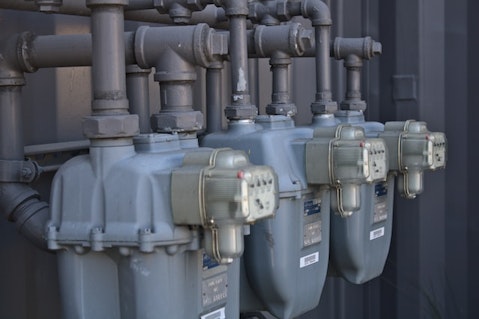USA Compression Partners, LP (NYSE:USAC) Q4 2022 Earnings Call Transcript February 14, 2023
Operator: Good morning, and welcome to the USA Compression Partners, LP Fourth Quarter 2022 Earnings Call. All participants are in a listen-only mode. After the speakers’ presentation, we will conduct a question-and-answer session. . As a reminder, this conference call is being recorded. I would now like to turn the call over to Chris Porter, Vice President, General Counsel & Secretary. Thank you. Please go ahead, Mr. Porter.
Chris Porter: Good morning, everyone, and thank you for joining us. This morning, we released our operational and financial results for the quarter and year ended December 31, 2022. You can find a copy of our earnings release as well as a recording of this call in the Investor Relations section of our website at usacompression.com. During this call, our management will discuss certain non-GAAP measures. You will find definitions and reconciliations of these non-GAAP measures to the most comparable U.S. GAAP measures in our earnings release. As a reminder, our conference call will include forward-looking statements. These statements include projections and expectations of our future performance and represent our current beliefs.
Actual results may differ materially. Please review the statements of risk included in this morning’s release and in our filings. Please note that information provided on this call speaks only to management views as of today, February 14, 2023, and may no longer be active at the time of a replay. I’ll now turn the call over to Eric Long, President and CEO of USA Compression.
Eric Long: Thank you, Chris. Good morning, everyone, and thanks for joining our call. I’m joined on the call by Eric Scheller, our COO; and Mike Pearl, our CFO. I would like to begin today’s call by highlighting USA Compression’s continued operational and financial improvements that were outlined in this morning’s earnings release. For the fourth quarter 2022, USA Compression generated record quarterly revenues coming in to slightly above $190 million. These record revenues were enabled by continued quarter-over-quarter fleet utilization improvements that resulted in a fourth quarter utilization exit rate of just under 92%. Along with increased utilization, we saw record setting quarterly per horsepower average revenue, and an approximate 10% increase in quarter-over-quarter distributable cash flow coverage, which came in at 1.18x.
We are very pleased with our fourth quarter results, which we believe speak to the durability of our cash flow stream and highlight the benefits of our focus on disciplined capital investment, which allows us to grow our fleet organically, while improving our utilization rates and financial performance. Last quarter, we discussed our positive views on the energy macro environment and our belief that we are in the early innings of a commodity price super cycle. Our views have not changed. We continue to expect the commodity price backdrop to remain supportive of production growth, which in turn continues to support the long-term demand for natural gas compression services. We believe the producers continued disciplined capital investment approach will sustain tightness in energy markets into the foreseeable future, thereby providing a commodity price backdrop that is supportive of continued drilling and therefore supportive of current and future demand for natural gas compression services.
Last quarter, we also explained that USA Compression’s operational and financial performance is more dependent on the production cycle than on the drilling cycle that correlates more closely with near to medium-term commodity prices. In recent weeks, the spot price for natural gas declined under $3 per dekatherm and remains depressed compared to historic levels as mild winter weather, LNG export delays, and rising inventories continued to depress spot and forward strip price natural gas prices. This sustained price decline was not anticipated, but also was not disruptive to our business. I would like to take our prior quarter analysis one step further to articulate specifically why near to medium-term disruption in natural gas prices do not change our views on the future demand for our natural gas compression services.
A large percentage of USA Compression’s fleet horsepower is located in basins that feature crude oil production. It is not possible to produce crude oil from shale without also producing associated gas that must be processed, treated, and/or transported. During periods of depressed natural gas spot prices, associated gas is considered somewhat of a byproduct of produced oil. However, natural gas status as a byproduct does not mitigate the immediate need to transport process or otherwise responsibly handle associated gas that is produced alongside crude oil. So long as crude oil production remains economic, producers will continue to produce oil along with associated gas volumes that require compression services to ensure proper and responsible natural gas takeaway.
Current surveys estimate breakeven WTI prices for existing U.S. onshore wells at approximately $30 and in the mid-$50 range for newly drilled wells. At these breakeven prices, we expect incremental drilling to continue, which supports future demand for natural gas compression services, irrespective of current natural gas spot prices. Even if WTI prices do not support new drilling, currently producing U.S. onshore shale wells continue to mature, causing the productive ratio of gas to oil to increase, which increases demand for natural gas compression to ensure the consistent volume flow of oil from existing wells. In USA Compression’s other operating regions such as Appalachia, Marcellus, there is little to no oil. So spot prices for WTI do not provide the same support for continued natural gas production.
In these gas in basins, pipeline permitting restrictions and depressed natural gas spot prices present challenges to future natural gas production growth. Notwithstanding producers continue to produce from existing wells because shutting in wells carries the risk of permanently damaging the reservoir and may cause financial detriments arising from firm transportation commitments. Overtime, continued natural gas production across these basins decreases field pressures, which increases the need and demand for additional natural gas compression. In basins like Appalachia, Marcellus depressed natural gas prices are conducive to USA Compression maintaining its current service levels with improved natural gas pricing presenting opportunities for incremental natural gas compression growth in the future.
To summarize, we do not use seasonally dislocated natural gas prices as a meaningful headwind to the pillars of USA Compression strategy that includes generating a durable stream of cash flow from our existing fleet, improving our financial performance by increasing fleet utilization, and practicing returns based capital investing, reducing leverage, and achieving financial optionality. Before turning the call over to Eric Scheller to discuss fourth quarter operating results, I would like to make a few comments regarding safety. As a company, the most important thing we can do is ensure that our employees return home safely each day. We are extremely proud of our tireless focus on safety that has resulted in a 2022 total recordable incident rate that was more than 80% lower than the industry average.
This is a significant accomplishment and I thank every USA Compression employee for the commitment and strict adherence to our safety policies and procedures. With that, I will turn the call over to Eric Scheller, our COO, to discuss our fourth quarter operating highlights.
Eric Scheller: Thanks, Eric, and good morning, everyone. USA Compression’s operational results continued to strengthen throughout 2022, resulting in record setting fourth quarter revenues that were and continue to be supported by a greater than 90% utilized fleet. Our full-year 2022 results were year-over-year improvement in revenues and gross profit margins that were achieved through our disciplined contract portfolio return approach that affords us pricing flexibility to continue securing market-based rates for our services. The heavy lifting accomplished from our 2022 capital planning and third-party contracting activity positions us to satisfy increased market demands for compression services, while protecting our cash flow during volatile and inflationary period.

Photo by Doris Morgan on Unsplash
For 2023, we continue to see an improvement in market backdrop that has gained momentum since the back half of 2022. Given current breakeven WTI prices, we expect commodity prices to remain supportive of future production growth, which will drive increased demand for our natural gas compression services. We believe that the oil and gas industry’s disciplined capital investment approach that focuses on free cash flow generation and returns based investing underpins the existing tightness in energy markets and will contribute significantly to continued market tightness into the foreseeable future. We also believe that the transition from a hydrocarbon-based energy world to a renewable-based energy world will take decades longer than anticipated and the financial costs of such a transition remain prohibited to most global societies.
Until there is a massive shift in cost, efficiency and efficacy of deployable, scalable, renewable-based solutions, natural gas compression will remain in demand consistent with EIA forecasts for increased levels of natural gas production into 2050. Now admittedly, the outlook for U.S. spot natural gas prices has trended lower as domestic gas production is expected to hit record levels in 2023, growing by more than 2 Bcf per day to average over 100 Bcf per day for 2023. Bear in mind that when USA Compression was formed in 1998, U.S. dry gas production was roughly one half of the current 2023 forecast, and the shale revolution of the early 2000s is the major contributor to the robust increase in domestic natural gas production and consistent with Eric’s messaging regarding production declines and reservoir pressures, many years of empirical evidence confirmed that continued production leads to lower producing pressures, which in turn requires an exponential increase in the demand for compression services to produce the same volumes of oil and natural gas.
Growth in shale production is also created meaningful incremental demand from our existing customers and has allowed us to pick up additional strategic accounts to expand our market share throughout our areas of operation, all the while maintaining a balanced and credit worthy bulk of business. Increased demand for compression has fueled our consistent climate and fleet utilization rates that improved throughout 2022, culminating in an exit utilization rate of approximately 92%. Pillowing the skin back a bit on utilization, we see a heavy dose of highly desirable Caterpillar 3600 class machines that are approximately 97% utilized and Caterpillar 3500 series units that are over 95% utilized. We expect overall fleet utilization to increase and sustain itself as commodity prices remain supportive.
Capital deployments by competitors continue to lag existing equipment availability continues to remain stressed and contract pricing and tenor improved, particularly for large horsepower units that are fleet features. Existing market tightness for compression assets provides us tremendous flexibility to lock in attractive service rates or remain flexible enough to opportunistically high grade return. For example, the year-ended December 31, 2021, approximately 33% of our compression services on a revenue basis were provided on a month-to-month basis. For the year-ended December 31, 2022, approximately 29% of our compression services on a revenue basis were provided on a month-to-month basis. The decline in month-to-month contracts is indicative of the demand for our services and our ability to monetize the value of our fleet with attractive rate contracts that feature improved tenors and result in attractive returns based in durable cash flows.
We are realizing improved contract terms from the deployment of our idle unit, as well as from contract renewals of currently deployed units. Current contract negotiations for existing units with existing customers spend around a 30-month average renewal tenor. New equipment deployments are attracting contract tenors that exceed 60 months and at rates that are higher than our historic per horsepower rates. We expect contract service rates to continue increasing as readily available equipment becomes scarce, and customers offer service certainty with longer-term contracts that are executed at attractive rates. Our improved contract tenors and service rates are supported further by our long-term customer relationships where all the one of our top 20 customers has been a customer for more than five years with several having been USA Compression customers for more than 20 years.
Our relationships also extend up the supply chain where USA Compression was able to navigate the supply chain debacle of 2022 in terms of securing delivery slots for new units. Our established and key relationships with packages and component providers allow us to gain visibility into deliveries with the ability to affect and anticipate final package deliveries to customers. Now we expect to remain on track to deploy and contract our new large horsepower unit orders in 2023, which will add approximately 165,000 of much thought after horsepower throughout 2023, under multi-year contracts. Now, while there were many reasons for our go-forward optimism, 2022 did present some challenges. We saw marked increases in the prices of fuel, fluids and labor, and although our contract-based adjustments allowed us to mitigate costs inflation, we did see modest declines in margins resulting from input cost inflation that preceded the dates that we were able to invoke contract rate adjustments.
Notwithstanding, USA Compression generally has been able to offset meaningful inflationary costs and we expect inflationary pressures to abate eventually and our adjusted gross margins to remain at or near their historic levels normalizing around 68%. 2022 also witnessed moderated demand for large horsepower electric compression as limitations of the existing electrical grid and the lack of availability of variable frequency drives persistent. Nevertheless, we have continued to commercialize dual drive technology with customers interested in continued production supply, while maintaining optionality on compression driver choice. We believe that our field proven dual drive initiative makes a lot of financial sense for our customers that sustain the benefits from lower operating expenses, increased reliability, 99% runtime, substantially lower greenhouse gas emissions, and the mitigation of interconnect delays.
As our deployed dual drive units continue to demonstrate their expected operational performance, reliability, and flexibility, we anticipate fielding additional indications of interest from customers that are seeking to deploy this cost efficient and more environmentally friendly solution to compressing natural gas. Consistent with our views on the transition to a renewable-based energy world, we believe the migration to wide scale compression electrification will be a multi-decade effort and will evolve alongside improvements to the electric grid and further demonstration of the dual drive value proposition of reliability and redundancy of the natural gas backup driver with the advantage of electricity as the prime power source. We expect that adoption of dual drive technology will be incremental and USA Compression remains poised to convert its large horsepower fleet to dual drive quickly, methodically, and cost effectively as the market for this technology evolves.
To close, we expect our 2023 results to reflect the benefits of our 2022 directed efforts to increase utilization, expand our fleet through strategic capital investments that are consistent with the growing demand from compression services and improved contract prices in tenors. With that, I’ll turn the call over to Mike Pearl, our CFO, to discuss fourth quarter financial results.
Mike Pearl: Thanks, Eric, and good morning. Today, we reported our fourth quarter results, which featured record quarterly revenue and quarter-over-quarter increases in adjusted EBITDA and distribution coverage, which increased by more than 10% on a sequential quarter basis to 1.18x. Our fourth quarter results were attributable to our continued commitment to improve fleet utilization and price discovery for newly contracted units. Our fourth quarter utilization exit rate increased by nearly 1% on a sequential quarter basis, while our quarterly average revenue per revenue generating horsepower improved to an all-time high of $17.81. Pricing improvements were driven by continued CPI price escalators for currently contracted services and by demand-driven rate increases for month-to-month and longer-term newly contracted compression services.
Adjusted gross margin percentage declined by 1.6% during the fourth quarter as increased prices for vehicle fuel, compressor fleet lubrication fluids and labor continued to front run the timing of contract-based CPI and market-based rate adjustments. We are beginning to see some abatement in fuel and lubricant costs, but wage inflation continues to persist. Overtime, we expect inflationary pressures to lessen, and we expect our margins to normalize at or near our historic averages. Our total fleet horsepower at the end of the quarter remained flat to the previous quarter at approximately 3.7 million horsepower. However, our quarter-over-quarter revenue generating horsepower increased by over 2%. Fourth quarter 2022 expansion capital spending was $46.1 million, and our maintenance capital expenditures were $3.7 million.
Expansion capital spending primarily consisted of reconfiguration and make-ready of idle units, the delivery of four new large horsepower units and the procurement of compression station components. Our maintenance capital spending decreased on a sequential quarter basis, notwithstanding our improved fleet utilization. Fourth quarter 2022 net income was $8.4 million. Operating income was $46.7 million. Net cash provided by operating activities was $82.1 million, and cash interest expense net was $36.2 million. Interest expense increased by approximately $3 million on a sequential quarter basis as a result of higher interest rates applicable to outstanding borrowings on our floating rate credit facility. During the fourth quarter, we also achieved another sequential decline in our bank covenant leverage ratio, which decreased to 4.76x.
We remain committed to improving our leverage metrics further and believe that improving market conditions operational and contract pricing improvements and continued capital discipline will allow us to continue reducing our leverage while delivering predictable, reliable and durable returns for all stakeholders. We have issued our full-year 2023 guidance. Operational improvements, capital efficiency and pricing power enabled by increasing demand underpinned our expectations to deliver improved year-over-year financial results. We expect adjusted EBITDA between $490 million and $510 million and distributable cash flow between $260 million and $280 million. Finally, we expect to file our Form 10-K with the SEC as early as this afternoon. And with that, I will turn the call back to Eric Long for concluding remarks.
Eric Long: Thanks Mike. We closed out 2022 with exceptional optimism given our fourth quarter results and what we are seeing in terms of future demand and pricing for natural gas compression services. We look forward to delivery and deployment of new large horsepower units throughout 2023, and we will remain focused on improving our fleet utilization as market conditions permit. On February 3, we paid out our 40th quarter of consecutive distribution payments. The distribution was flat to the previous quarter’s distribution at $0.525 per unit. In 2023, we will continue to work toward reducing our leverage, while providing meaningful returns to all stakeholders. Improvements to fleet utilization, contract tenors and contract pricing position USA Compression for future optionality in terms of further capital investment, debt reduction and changes to distribution policy.
USA Compression will continue delivering best-in-class compression services to its customers, maintaining capital discipline and focusing on driving improved financial performance. To conclude, we are extremely pleased with our fourth quarter results, highlighted by record quarterly revenues and quarter-over-quarter improvements in utilization, financial results, distribution coverage and leverage metrics. We look forward to discussing our first quarter 2023 results with you in a few months’ time. And with that, we will open the call to questions.
See also 10 Best Three-Row SUVs of 2023 and 12 Most Undervalued Retail Stocks.
Q&A Session
Follow Us Alliance Corp
Follow Us Alliance Corp
Operator: Thank you. . Our first question will come from TJ Schultz from RBC Capital Markets. Please go ahead. Your line is open.
TJ Schultz: Great. Thanks. Good morning. I think just first thinking about volatility in natural gas prices, Eric; you walked through how you all are fairly insulated. And I assume the EBITDA guidance considers the near-term spot price on natural gas. But how could lower prices impact your level of growth capital spend in 2023? What do you expect to spend right now? How quickly can you turn that on or off? And how are these recent prices potentially impacting customer decisions on activity levels and spending on things like compression? Thanks.
Eric Long: Great question, TJ. The first thing, when we looked at 2023, we contemplated basically de minimis, if any, growth CapEx in dry gas basins. Everything is associated gas a lot in the Permian, Delaware, to a lesser degree, a little bit down in the Eagle Ford and then some stuff up in the Mid-Continent, all of which tend to be oily plays. We follow incremental activity. We’ve seen rig count declining up in the Haynesville and visiting with our producers that we have out there. It appears that there indeed is a slowdown based on commodity pricing. We have an established long-term footprint since the formation of the company up in Appalachia, which has then also expanded in with the other shale developments that you’ve seen outside of the Marcellus proper.
That area has been, from a new growth activity, relatively slow for a few years because you don’t have enough pipeline takeaway capacity. So folks that have firm transportation in the area continue to kind of offset decline. We’ve actually been installing additional stages of compression to continue to help boost and offset the need for either decline in production or drilling new wells. So again, we came into 2023 not contemplating growth in the dry gas areas. I think that has held to be true. And when you look at the spot prices for crude oil, you look at the bottlenecks you’ve got with takeaway capacity for natural gas; the basis differential is pretty low on gas prices coming out of the Permian and the Delaware as well. So where people are making their money, of course, is on the oil side.
We’re involved with the gas lift process. People don’t want to flare anymore. They would — so even if there’s minimal value associated with the residual process dry gas stream coming out of the Permian, Delaware, people want to be ESG compliant. People want to make some spreads on some of the liquids on the propanes and butanes, et cetera, that are coming out. So bottom line is no change in our outlook for 2023. Our demand signals are extremely strong. And in fact, to the extent that the supply chain would allow for even more compression horsepower, the demand is there. So I think we’re all in a unique spot that those of us that have financial resources can continue to promulgate growth CapEx. And again, TJ, we don’t see any impact coming out of the dry gas side for us in 2023 and well on into 2024 as well.
TJ Schultz: Okay. Great. And then, at your guidance level, you’re getting more financial flexibility. What’s your target debt leverage before we should be asking about things like distribution growth and buybacks? And then also what is the expectation with conversion or redemption on the preferred?




